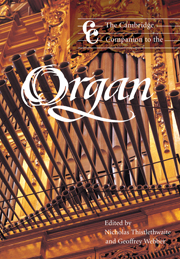Book contents
- Frontmatter
- Part I The instrument
- Part II The player
- Part III Selected repertoires
- 10 Italian organ music to Frescobaldi
- 11 Iberian organ music before 1700
- 12 The French classical organ school
- 13 English organ music to c1700
- 14 Catholic Germany and Austria 1648–c1800
- 15 The north German organ school
- 16 The organ music of J. S. Bach
- 17 German organ music after 1800
- 18 French and Belgian organ music after 1800
- 19 British organ music after 1800
- 20 North American organ music after 1800
- Appendix: The modes (toni) and their attributes according to Zarlino
- Notes
- Bibliography
- Index
17 - German organ music after 1800
from Part III - Selected repertoires
Published online by Cambridge University Press: 28 September 2011
- Frontmatter
- Part I The instrument
- Part II The player
- Part III Selected repertoires
- 10 Italian organ music to Frescobaldi
- 11 Iberian organ music before 1700
- 12 The French classical organ school
- 13 English organ music to c1700
- 14 Catholic Germany and Austria 1648–c1800
- 15 The north German organ school
- 16 The organ music of J. S. Bach
- 17 German organ music after 1800
- 18 French and Belgian organ music after 1800
- 19 British organ music after 1800
- 20 North American organ music after 1800
- Appendix: The modes (toni) and their attributes according to Zarlino
- Notes
- Bibliography
- Index
Summary
In 1845, Félix Danjou, the director of the French firm of organ builders Daublaine-Callinet, writing in the first edition of his magazine Revue de la musique réligieuse, populaire et classique, commented on the state of German organ composition:
In Germany, not a step has been taken since Seb. Bach: the compositions of Adolphe Hesse and of Rinck always belong to the legato fugal style which Bach used exclusively in his works. Without doubt there is more freedom, less constraint, from the standpoint of the use of the legato style, in the compositions of Seb. Bach than is to be seen in the works of modern German composers.
(quoted in Kooiman 1995: 57)Danjou's generalisations on the music of the Thuringian Christian Heinrich Rinck (1770–1846) and the Silesian Adolf Friedrich Hesse (1809–1863), composers who might be said to have laid the foundations for nineteenth-century German organ music, while having an element of truth, are one-sided and not entirely accurate – for example, both composers wrote in equal measure in the legato fugal style and in the free variation manner. If organ music had failed to maintain the lofty standards of J. S. Bach, one has to look at least a hundred years earlier and to forces external to music for the causes of decline. Movements in philosophy and the arts such as Aufklärung (Enlightenment) and Empfindsamkeit (sensibility) had challenged accepted norms and traditions. The Church lost its centrality in society, and had to compete with man's growing belief in his own self-sufficiency, as well as with a rise in nationalistic fervour.
- Type
- Chapter
- Information
- The Cambridge Companion to the Organ , pp. 250 - 262Publisher: Cambridge University PressPrint publication year: 1999



